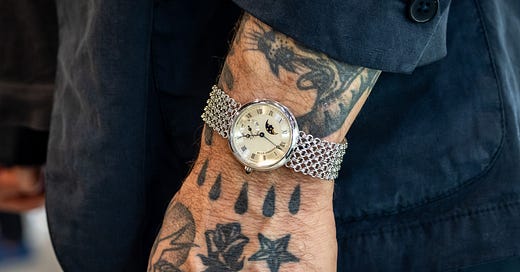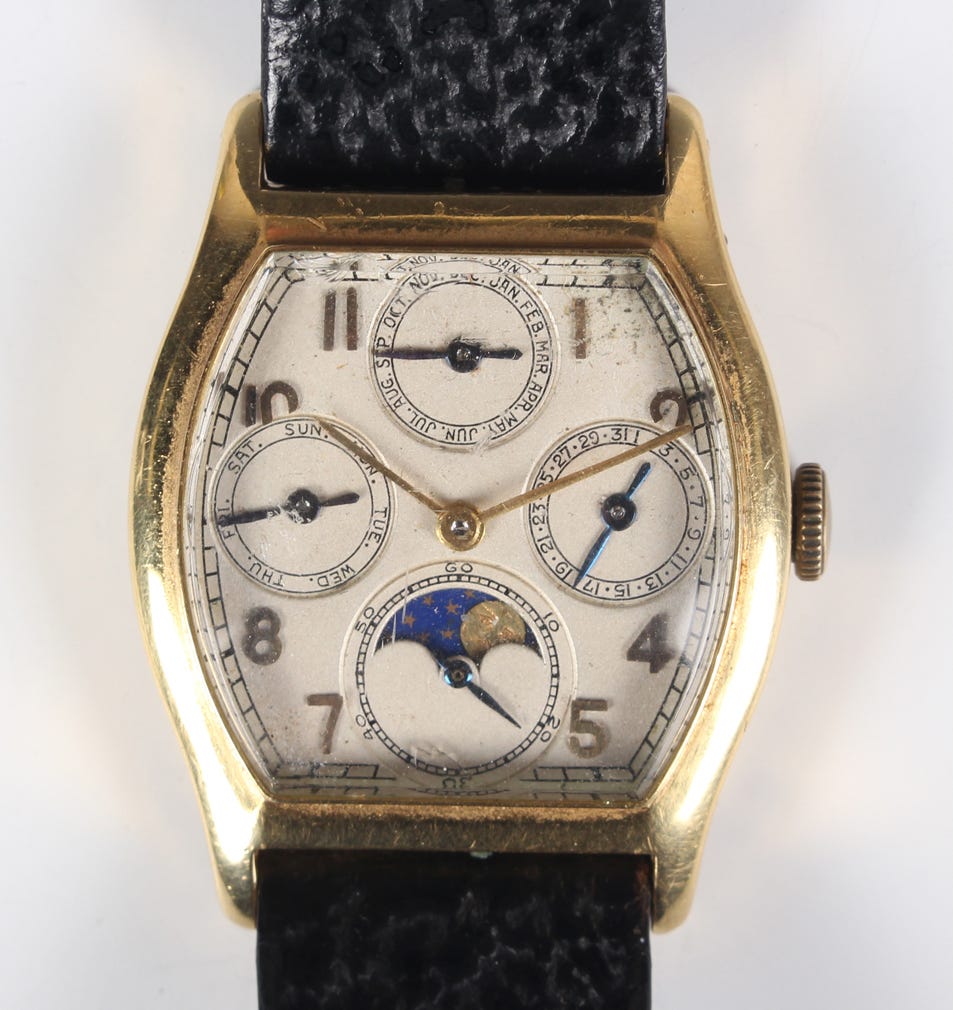May Update: Friction As A Feature
Treasure hunting and three special vintage Tanks at auction – can your GPT do that?! (Don't answer that)
Welcome to my monthly update, and thanks to all the new subscribers who have somehow found me in the last two weeks. My Hodinkee highlights and treasure hunting for a few cool Cartiers at small auctions below, but first:

The watch world is full of friction. For a product that is, fundamentally, a superfluous anachronism, I suppose this makes sense and I’ve tended to think it’s a feature, not a bug. We’ve come a long way from trading information and watches on forums, but everything can still be incredibly inefficient and full of friction.
Most good info is still hidden away on some old website or isn’t even online, existing only in print or the dark recesses of some dealer’s mind. Meanwhile, buying a watch, if you find one, is often especially manual, with wire info and confirmations being sent around so carelessly that you hardly have to be Edward Snowden to be concerned. And as a former contracts lawyer, it still boggles my billable hour that five- and even six-figure deals are sometimes secured with nothing more than a “🤝,” and this is as good as bond.
Sometimes this friction has a fun euphemism: “price on request,” “building a relationship with your SA,” or other such nonsense. If you’re an investor-type who values words like scale or efficiency, you’d look around the watch industry and see nothing but opportunity and you’re probably not wrong.
But this, to me, misses something. Hardcore enthusiasts/sickos seem to relish the friction. Digging up old auction catalogs or books, finding the right dealer with the right watch, even “building a relationship” – it’s all part of the fun. The treasure hunt. A hobbyist category like watches (at least, “collectible watches” or “enthusiast watches,” the definitions of which we can argue about another day) doesn’t exist to be optimized and scaled but to be nurtured and enjoyed.
This all sounds very romantic and I’m not saying this friction is always good – sometimes it’s actually bad, or at least, frustrating. Often, it results in an asymmetry of information that hurts clients/consumers.
But I hope it’s at least a little bit true because the biggest news of the past couple of weeks in the publishing world has been Google rolling out ChatGPT-like “AI Overviews” answers to more and more search queries. It promises to reduce the friction of finding information, watches, whatever. Of course, some of the preliminary results are better than Google literally telling people to glue their cheese to pizza. But long term, the net effect will probably be less and less traffic to the actual websites that produce actual information.
This is all very scary and some media thinkers are (rightly) concerned. It’s likely bad news for an industry that’s already been decimated.
But many of these scary new AI things still seem to be looking to humans or experts for endorsement. The whole Scarlett Johannson vs. OpenAI thing, for example. I alluded to a similar AI-driven project in watches in my last update that I won’t dwell on, but the basic idea is using watch experts to endorse what are fundamentally computer-generated answers.
For many questions, computer-generated answers might be enough. Think of this as the “What time is the Super Bowl?” category of questions that any quarterback with a keyboard could answer. In watches, that could be things like new releases or the dreaded “5-best-whatever” listicles.
But for the important stuff, I tend to think people are smart enough to understand the difference between computer-generated and human-curated, and the latter becomes exponentially more valuable when done right. It’s not easy and there’ll be a lot less low-hanging fruit, but that’s fine.
I briefly mentioned the importance of human curation back in January, but it feels more urgent just six months later. Whether you’re a dealer, content creator, or whatever else, curation is hard.
But in watches, at least, this friction is often a feature.
Articles of The Month
One of the areas that, despite the efforts of aggregators like Invaluable and others, continues to have a ton of friction, is auctions. A few of my longer pieces this month were about the big sales in Geneva:
📝 To Read:
As I wrote last year, major auctions can be marketing exercises as much as they represent a true market nowadays….
The other day my wife was evaluating some investment prospectus (watch out Wall Street!) and I joked that if your prospectus isn't filled with graphs that are trending up and to the right then you're not trying hard enough.
The point of this cute little anecdote is not that I made a funny (?) little joke, but that this is also basically how I felt about the auction results from Geneva. Prices were decidedly mixed and whether or not they were good or bad is mostly a "glass half empty" or "half full" question of perspective. The delayed Only Watch charity auction set the tone for the weekend. The top (Patek Philippe, mega indies like Journe, Voutilanen, and Rexhepi, and up-and-comers like Auffret, Petermann Bedat, and Sylvain Pinaud) performed well, most results were average, and a few poor results dragged down overall sentiment.
In the rest of this auction recap, we talk about when “scholarship changing” is good and when it’s not; other ‘bewildering’ descriptions; Cartier up, indies down, and more.
🎧 To Listen:
Hodinkee Radio: Conversation with Eric Ku and Justin Gruenberg
I enjoyed my conversation with Eric Ku and Justin Gruenberg this past week – we discussed auctions, the market, what dealers and auction houses can do better, the watches they’d steal from each other if they could, and a lot more. Obviously, the two Loupe This co-founders are familiar to many, but I thought the topics we touched on and their opinions were fresh and it’s one of my favorite episodes of Hodinkee Radio this year.
…Speaking of ‘the treasure hunt’
The big-time Geneva auctions represent a relatively small fraction of the auction world, and often I have more fun following the mid-size houses. There are at least a handful of solid watch-focused sales over the next few weeks. Not a small house, but Sotheby’s London has a sale led by a London Tank Cintree that’s already at £200k with a couple days left. A few other quick highlights:
1920s (?) Jaeger-LeCoultre Tonneau Calendar
This vintage JLC already hammered for £50,000 (£62.5k all-in), but it was too good not to share. Beautiful tonneau-shaped case and an unsigned dial, but the movement inside is signed Jaeger-LeCoultre. According to the UK auction house, it was a gift from the once-richest man in Britain and came from the family of the original owner. A beautiful watch that I wouldn’t be surprised to see cleaned up and offered elsewhere sometime soon. So many brands were using JLC calibers during this time and if one of their names happened to be on this dial, it could’ve easily been a six-figure watch. One of those brands is of course…
Next is this 1940s Cartier Tank Chinoise, offered at a Milanese auction house. Cream-colored dial, Breguet hands, and brick bracelet, it truly doesn’t get much better. This one has a European Watch Company movement and it’s hard to expect a 1940s Tank to be in much better condition than this. Of course, there’s some wear on the dial’s edges, but these things were about as waterproof as cotton candy. In these photos, the railroad track looks a little sloppy, but the rest of the dial looks fine so I’m inclined to say this might even just be some distortion from the bevelled crystal but would need to investigate further.
The starting bid is €8,000, but Analog Shift has had this later 60s Chinoise listed for $40,000 for quite a while if that gives you any feel for where this might land.
1970s Cartier Tank Auto in White Gold
Finally, a well-known Swiss house also has a solid upcoming watches sale. There are a number of nice pieces, especially from the ‘90s, that I could’ve mentioned – gold AP QP RO,1 anyone? – but I thought I’d stay on theme and feature this white gold Cartier Tank Louis with an automatic movement. The ref. 17002 Tank Automatic is much rarer than the standard ‘70s Tank Louis and a bit bigger (35x28mm). Mark 2 dial for those who read my 1970s Cartier Collector’s Guide, which makes sense for the early serial number, and pretty rare in white gold.
This one seems to be in decent condition but I also had to mention it because of the (aftermarket) white gold cuff it’s paired with (on Cartier deployant). Very Ralph Lauren. The rest of the sale, headlined by a 1518, is worth a scroll.
Finally, If you’re looking for something a little more affordable, I always love a good Movado eBay find with a blurry photo.
That’s all for this Memorial Day weekend. Thanks as always for reading, and please like and share. See you next month or follow me on IG for updates.
-Tony
P.S. I enjoyed reading The Conquest of Cool over the holiday weekend. It’s a bit academic but an eye-opening look at how the advertising industry co-opted the counterculture of the ‘60s. There’s a ton to be applied to watches – maybe especially in conjunction with Professor Pierre Yves-Donze’s new book about Rolex that focuses on the same era. More to come, perhaps.










The hybrid approach where AI can assist an expert human with the more mundane tasks of research is an under developed use case in the watch world. Gives you more time to focus on where you can add the most value.
How might AI make your job easier, rather than trying to steal it? I’d be curious to know if and how you’re already using AI in your work.